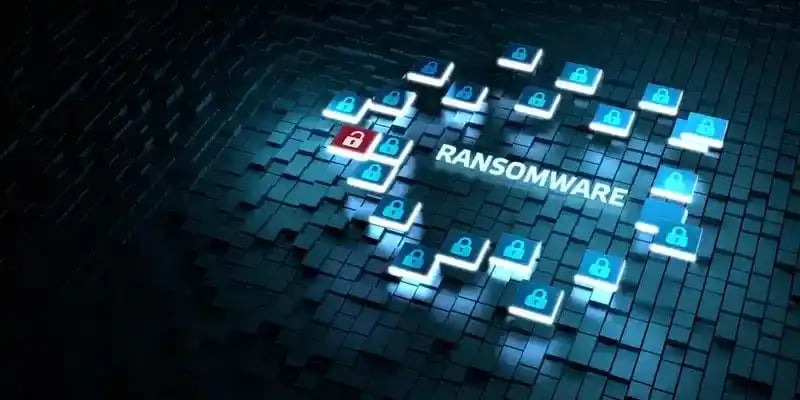Ransomware Resilience: Prevention and Recovery in 2024
Date: 29 January 2024

What does Ransomware Resilience entail? Is prevention even possible and what are the best strategies for recovery in 2024? We delve into all the answers in 2024.
In this blog, we cover:
- Why is Ransomware Resilience Important in 2024
- Things You Should Know About Ransomware in 2024
- Steps for Ransomware Prevention in 2024
- Ransomware Response & Recovery Strategies for 2024
Download our FREE Ransomware Response Playbook for Executives created by the cybersecurity experts at Cyber Management Alliance. Build greater resilience against ransomware attacks with the strategies for Ransomware Response and the expert insights and tips shared in the non-technical handbook for executives.
Why is Ransomware Resilience Critical?
In May 2023, Clop Ransomware Gang’s attack on MoveIT created ripples that victims across the globe continue to feel. Instead of encrypting files, the gang merely continues to extort the thousands of victims, threatening to leak the data unless a ransom is paid.
2023 began with LockBit Ransomware Gang bringing Britain's legacy organisation, Royal Mail, to its knees with a massive attack that resulted in thwarting international shipments and postal services.
In September, ransomware attacks on two of the biggest names in the Casino and Entertainment space, Caesar’s and MGM Resorts made headlines. MGM Resorts experienced a 36-hour system shutdown as a result of a ransomware attack, resulting in significant downtime expenses and monetary losses. Cyber attackers specifically targeted and accessed the "Caesar's Rewards" loyalty programme database.
And the worst part is that these attacks are merely the very tip of the iceberg when it comes to Ransomware infections in 2023.
The world has witnessed a massive rise in ransomware attacks over the last couple of years. In 2023, these attacks that run into thousands have posed serious threats to individuals, businesses, educational institutions, healthcare and governments alike.
As we move into 2024, understanding and implementing effective strategies for ransomware prevention and recovery has become more critical than ever. In this blog, we delve into comprehensive methods to build resilience against these malicious attacks, ensuring preparedness and swifter ransomware response in 2024.
What You Need to Know about Ransomware in 2024
Ransomware is a type of malware or malicious software which locks and encrypts a victim's data. The ransomware attacker usually demands that the victim pay the ransom for the release of encrypted data. Over the years, ransomware has evolved from simple locker viruses to sophisticated ransomware variants that target critical infrastructure and large organisations.
Ransomware attackers have now orchestrated large-scale gangs and have affiliates that have spread the tentacles of this massive scourge far and wide. The advent of Ransomware-As-A-Service has made matters worse. Now almost anyone on the dark web, can download ransomware kits that are vehemently marketed and use these easy and cheap tools to launch large-scale attacks that can cause significant damage.
The writing on the wall, then, is clear. Every business that values its market reputation and bottomline has to build an effective Ransomware Resilience strategy with great agility. It is nearly impossible to prevent ransomware attacks altogether. But what is possible to be prepared against them and ensure that you recover as fast as possible while preventing significant damage to your operations and sensitive data.
Steps for Ransomware Prevention in 2024
By regularly undertaking the following security measures in 2024, you can considerably reduce your risk of being attacked and protect against ransomware infections.
You can start by downloading our 9-point Ransomware Prevention Checklist, created by the experts at Cyber Management Alliance. This downloadable and printable list is great for top-of-the-mind recall of all the things you need to do on a regular basis to prevent unauthorised access to your networks, systems and data.
- Regular Software Updates and Patch Management: One of the most effective ransomware prevention strategies is maintaining up-to-date software and systems. Regular updates and patch management plug vulnerabilities that could be exploited by ransomware and cyber attackers. Make sure that your organisation encourages everyone to regularly update their software and operating system, and any patches announced are implemented with agility.
- Advanced Threat Protection Tools: Incorporating advanced threat protection tools into cybersecurity strategies is essential. These tools use artificial intelligence and machine learning to detect and prevent ransomware attacks before they occur.
AI algorithms are capable of analysing vast amounts of data at a rapid pace, identifying patterns and anomalies that might indicate a potential ransomware attack. This proactive detection is crucial, as it can flag unusual activities before the malware has a chance to encrypt files or spread across the network.
Additionally, ML can be used to train systems to recognize the signatures of known ransomware variants and predict new ones based on similarities in behaviour and code. These technologies also assist in automating cyber incident response protocols, enabling quicker isolation of infected systems and minimising the impact of an attack. - Employee Training and Cybersecurity Awareness: Educating employees about the risks and signs of ransomware is critical. They must know how to detect anomalies and when to inform the IT team if something in their system seems amiss.
At Cyber Management Alliance, we conduct a suite of high-quality NCSC Assured Trainings in Cyber Security Awareness. These include the NCSC Assured Training in Cyber Incident Planning and Response, Building and Optimising Incident Response Playbooks and Cyber Security & Privacy Essentials.
While the former two focus on how to respond to and recover from a ransomware or cyber attack, the latter focusses on fundamental essentials of security that every employee should know. Some of the key aspects that the CSPE training focusses on include:
- How to identify a phishing scam
- What ransomware really is
- What is password security and why is it important
- What is Business Email Compromise
- The most common Human Errors that pose serious security risks
- Backup and Recovery Plans: Data backups play a crucial role in ransomware resilience as they serve as a safety net, ensuring that you can recover data without succumbing to the demands of attackers. In the event of a ransomware attack, where data is encrypted and held hostage, having up-to-date backups allows your business to restore its data quickly and efficiently. Quick data recovery minimises downtime and operational disruptions.
This not only protects against data loss but also significantly reduces the leverage attackers have, making the threat of withholding data less potent. Regularly scheduled backups, ideally stored in multiple locations including off-site or in the cloud, ensure data redundancy. This strategy is vital for maintaining business continuity and protecting against ransomware attacks.
- Regular Security Audits: Regular security audits such as our Ransomware Readiness Assessment are essential for ransomware prevention. They provide a systematic evaluation of your organisation's cybersecurity posture. These audits help identify vulnerabilities in IT infrastructure, software, and policies that could be exploited by ransomware attackers.
By conducting thorough assessments, organisations can proactively discover and patch security loopholes, update outdated systems, and reinforce weak areas in their network. This ongoing process also includes reviewing and updating access controls and employee privileges to minimise the risk of internal threats.
If you don’t know where to start and how to conduct a Cyber Breach Readiness Assessment consider services like our cost-effective and easily accessible Virtual Cyber Assistant and Virtual Cyber Consultant services. Our expert cyber security consulting services will help you review your existing cybersecurity posture and guide you on how to improve it at a pace that suits your business.
Ransomware Response & Recovery Strategies
As ransomware continues to evolve, so must our strategies to combat it. The best ransomware response and recovery practices in 2024 revolve around swift and decisive action, robust preparation, and continuous improvement of security measures. By adopting the below strategies, you can enhance their resilience against ransomware attacks, ensuring your data, operations, and reputation remain secure.
Before we get into the precise strategies, make sure you download our free Ransomware Response Workflow Guide. Created by Ransomware Response experts at Cyber Management Alliance, this visual workflow is very helpful when you’re under attack and in the midst of chaos.
Use it in conjunction with our Ransomware Response Checklist for a cohesive and organised response to ransomware attacks.
- Immediate Ransomware Response Strategies: Quickly identifying a ransomware attack is critical. Once identified, isolate the affected systems to prevent the spread of the malware.
After isolation, put your Cyber Incident Response Plan and Ransomware Response Playbook into effect immediately. Make sure your plans and playbooks are well-rehearsed by the first responders through Cybersecurity Tabletop Exercise.
Lastly, consult your legal counsel and/or cybersecurity consultants to understand the implications of the attack, especially regarding data protection and regulatory compliance. - Data Recovery and Business Continuity: In the event of an attack, secure backups ensure that critical data can be restored with minimal loss. Your recovery and response strategy should be focussed on restoring backed up data and ensuring seamless business continuity.
Remember, even if for some reason, you are not able to restore your data, it is never advisable to pay the ransom. Don’t ever enter into negotiations with the attacker. There is no honour amongst thieves in the cyber world. This means even if you do pay, there is absolutely no guarantee that they’ll give you your data back.
Communication is key at this stage. Informing stakeholders and employees about the situation and the measures being taken is vital for maintaining trust and operational coordination. Engaging with cybersecurity experts to analyse the attack, remove the ransomware safely, and patch vulnerabilities is essential to prevent future incidents.
- Strengthening Defences: Conducting a thorough analysis in the aftermath of the attack is imperative for proper ransomware recovery. After managing the immediate threat, conduct a comprehensive analysis of the attack to understand how it happened and to identify any security gaps.
Update security protocols, software, and systems based on the insights gained from the analysis. It is also advisable to invest in advanced cybersecurity solutions, including AI-driven security tools that can predict and prevent ransomware attacks.
Conducting regular security audits helps in identifying vulnerabilities and reinforcing security posture. Similarly, regular cyber tabletop testing can ensure that your ransomware response plans and strategies are up to scratch and effective.
Finally, make it a priority to stay abreast with all recent ransomware attacks and trends. A historical perspective on recent cyber attacks and ransomware attacks can seriously elevate your knowledge and preparedness.










